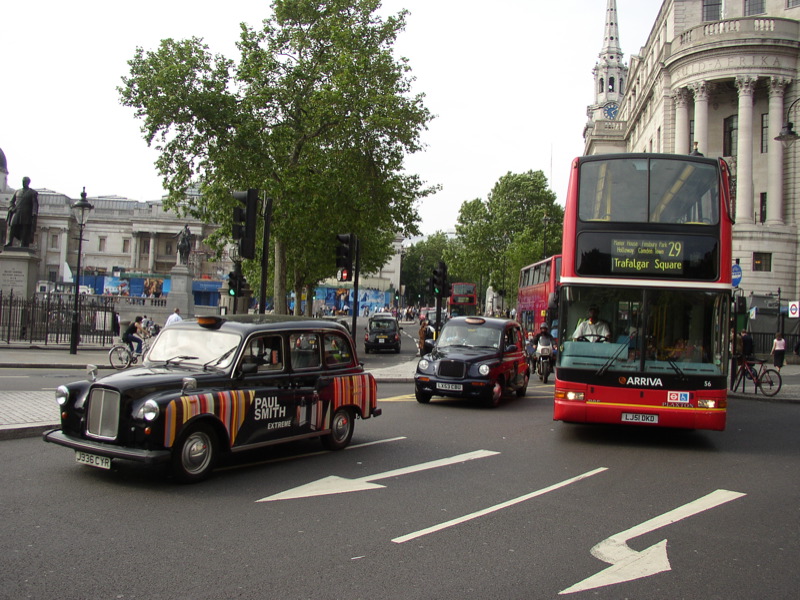Driving in England and the U.S. Posted by Gary Locke on Feb 15, 2018 in Culture, English Language, English Vocabulary
By now you probably know that drivers in the U.S. drive on the right-hand side of the road, but in the U.K., they drive on the left. As someone who has driven in both countries, believe me when I say that it is not an easy adjustment to make. Everything just looks wrong, not least of which is the placement of the steering wheel and the gear shift. There are also some quite different vocabulary terms to learn. Let’s explore some differences between driving in the two countries in case you should ever find yourself behind the wheel and don’t want to go ‘round the bend or off your trolley.
The History
When the ancient Romans built the first roads in Britain, travelers always kept to the left side for the very practical reason that right-handed soldiers wanted to have easy access to their weapons for defense. If you were in the left-handed minority, too bad. This practice continued for centuries, always for defensive purposes. Mounting and dismounting your steed was also easier from the left, making it safer than dismounting in the center of the road. Honestly, it makes perfect sense! Why, then, do so many countries, including the U.S., drive on the right?
By the 16th century, trade was more important than defense. A soldier on horseback was becoming an uncommon sight. Larger wagons, pulled by two or more horses, became an important means of commerce on roads worldwide. To better control the horses, the driver sat behind the left rear horse, keeping his right hand free to whip the horses, while maintaining the ability to pull with both hands as necessary. Since the driver was seated to the left, to facilitate passing traffic, the driver kept to the right side of the road.
Then it became political. The trend for driving to the right infuriated the British, who wanted to establish a firm rule. This became the Highway Act of 1835, which outlawed driving on the right. In France, however, the left-handed Emperor Napoleon, looking for any excuse to counter England, ruled that all traffic on French territory would be on the right. As the two powers continued to colonize across the globe, there was no consensus on which side to drive on. The United States, which had broken with England just 60 years before and was a major trading partner with France, opted to embrace the right-side travel rule.
It became permanent when Henry Ford introduced his Model T automobile in 1908, with the steering wheel on the left side. Since this was the first mass-produced automobile, and it was being sold worldwide, if you wanted to drive one, you had to drive on the right. Canada, Italy, and Spain quickly adopted the switch, leaving the current and former English colonies, such as India and Australia, among the lone holdouts.
British vs. US driving vocabulary
The differences don’t end with which side of the road we drive on, or where the steering wheel is situated. There are some distinctive road terms in each country.
- In the U.S. we back up. In the UK, we reverse.
- In the U.S. a two-door hardtop is a coupe (pronounced “coop”). In the UK it is a coupé (pronounced “coo-pay”)
- In the U.S. a four-door hardtop is a sedan. In the UK it is a saloon.
- In the U.S., pedestrians use a crosswalk. In the UK, they use a pedestrian crossing.
- In the U.S., drivers use their directionals to change lanes. In the UK, they use their indicators.
- In the U.S. we fill our cars with gas. In the UK we fill up with petrol.
- In the U.S. we check the oil by looking under the hood. In the UK we lift the bonnet.
- To change a tire in the U.S. we open the trunk. In the UK we open the boot.
- In the U.S. we drive on a highway. In the UK we drive on a dual carriageway.
- In the U.S., roads are separated by medians. In the UK, they are separated by central reserves.
- In the U.S., a road junction at which traffic moves in one direction around a central island is called a traffic circle. In the UK it is a roundabout.
- In the U.S. we drive trucks. In the UK we drive lorries.
- In the U.S., an oversized truck carrying a large trailer is a semi or 18-wheeler. In the UK it is an articulated wagon (or, Artic).
- If we want to change direction in the U.S. we do a U-turn, but in the UK, we pull a 180.
Can you think of any other differences between driving in the United States and driving in Great Britain?

Build vocabulary, practice pronunciation, and more with Transparent Language Online. Available anytime, anywhere, on any device.




